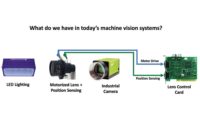Standards for machine vision technology and integration in the industrial automation marketplace continue to evolve as new technologies emerge. New standards and guidelines for application analysis and specification, validation, and measurement of capabilities will inform and enable better integration of inspection technologies across widely varying use cases. In this article, we review key standards that currently exist and provide an overview on recent updates and potential changes that will impact and benefit users of machine vision technologies. We also look at the work of various organizations to understand how their standards may impact the machine vision market.
The Value Of Standards In Machine Vision
Over machine vision’s long history in industrial automation, the emergence and development of standards has been one of the key drivers in advancing this technology and its broader usage. Standards for the interoperability and interconnectivity of components and for systems implementation and performance measurement make machine vision easier to use. Standards also create an environment where the focus is more on applications and less on the details of whether individual components will match and/or work together as expected. Furthermore, standards serve to help reduce costs in both the manufacturing of vision components and in system design and installation.
Lens mounts are a good example. The ubiquitous C-mount has long been one widely accepted de-facto, or informal, standard. The specifications for it and other lens mounts are now published as formal standards. This standardization is critical to ensure that lenses from different manufacturers attach correctly to diverse cameras and provide the exact back-flange distance to create a consistent image regardless of the components. Of course, standards are more than just physical specifications, and a broad range of standards for machine vision are in development.
Standards Activity Overview
Machine vision standards are developed and supported to provide consistency in software and firmware and interfaces between components and for performance measurement and evaluation. Working groups from many companies around the world collaborate to develop and constantly refine these standards. In most cases, one of several global trade associations hosts and manages a set of standards. These associations work together to promote and help organize the development of standards.
These groups include the Association for Advancing Automation, or A3 (automate.org); the European Machine Vision Association, or EMVA (emva.org); the Japanese Industrial Imaging Association, or JIIA (jiia.org); the German Engineering Federation, or VDMA (vdma.org); and the China Machine Vision Industry Alliance, or CMVU (china-vision.org). These five vision associations meet regularly to coordinate standards development and promote each other’s standards globally in an effort referred to as the G3. Closely related to standards, guides are also available — and in process — to help users design and integrate machine vision solutions successfully. While all machine vision standards are important, perhaps the most recognizable are those that address camera interfaces.
Camera Interface Standards
Camera interface standards deal with the hardware and the software used by component cameras and other imaging systems to connect to and communicate with computers and processors. In terms of hardware, each standard identifies the cables and connectors that will successfully interface with a computer or device (e.g., frame grabber) that follows the same standard. In some cases, the interconnect is unique to the individual standard, but in others, the connections and cables are familiar and widely used in a computing environment.
Hardware Standards
The machine vision marketplace provides five dedicated unique hardware standards for camera interfacing. These are Camera Link, Camera Link HS (CLHS), CoaXPress (CXP), GigE Vision, and USB3 Vision. Another nondedicated, general-purpose computer interface also can be used in machine vision applications — IEEE 1394, or FireWire. The physical attributes regarding cables and connectors for each of these interfaces vary widely as do the specific capabilities of each interface with respect to speed, power implementation, computer interface, cable length, and even the type and composition of the cables. Some selection criteria will be discussed briefly later, but as always, a detailed study of each specification is recommended relative to any individual application.
Software Standards
One camera interface software standard defines the low-level code that executes the communication between the camera and processor. At the most fundamental level, the interface standard indicates the software implementation of a transport layer that executes the physical communication with the camera. Depending on the interface, either a unique, dedicated frame grabber or a standard computer bus adapter is used on the processor side, along with driver software that implements the transport layer communications.
Another software layer associated with camera interface standards is the SDK (software development kit). The SDK provides the interface between a machine vision application and the low-level communications needed to execute basic functions such as identifying connected cameras, configuring cameras, acquiring an image, and handling signals and events passed from the camera. SDKs may vary slightly depending on the camera or interface device manufacturer but overall will adhere to an individual interface standard.
Two different software interface standards exist for machine vision components. In most hardware interface standards, GenICam (Generic Interface for Cameras) is either the mandatory or optional programming interface. This flexible standard is implemented in both the camera and device. In different modules, GenICam provides a method for common naming of features and pixel formats, defines how to implement a generic interface with the camera, indicates communication techniques associated with the transport layer, and controls protocol and data packets. In the various hardware standards, all or some of these modules might be mandatory or optional.
A second software interface standard relates exclusively to IEEE 1394/FireWire hardware. The IIDC2 standard was developed as an extension of the original Apple IIDC FireWire specification to provide consistency in the control and interface of machine vision cameras using a FireWire connection.
Selecting A Camera Interface Standard
A detailed discussion of camera interface standard selection is beyond the scope of this article. In general, the selection is based on the needs of a specific application. Still, this can be a complex decision based on multiple interface attributes and even subjective preferences. Noted here are some of the practical differentiators to take into account:
- Bandwidth (speed): Each interface has a specified maximum data throughput capability (which could be considered as image rate) with variations sometimes even within the standard based on cabling configuration. For example, some interfaces require multiple taps (cables) to achieve a higher data transfer rate. As noted below, recent developments in certain standards have resulted in greater speed and bandwidth for those interfaces.
- Connector preference: The physical connection between the camera and interface device, or frame grabber, might be a consideration in some cases. Of interest could be the physical robustness of the connector and cable for use in a certain application. For example, robotic applications may require cables with high stress tolerance and low bend radius. Another consideration is whether the interface can be easily implemented in optical cabling.
- Cable length: Cables for different interfaces have dramatically different maximum lengths per the specification. As mentioned, some interfaces natively support optical fiber cables thereby extending the possible length of transmission.
- Type of interface: Some interfaces require a dedicated interface card, or frame grabber.
- Other considerations: GenICam compliance, acquisition trigger type and latency, signal jitter, transmission robustness or redundancy, and other considerations could be of interest in specific applications.
The G3 put together a very useful brochure titled Guide to Understanding Machine Vision Standards. This brochure provides a common template for describing each standard, which allows unbiased comparisons of each standard’s capabilities. The brochure is accessible from any of the G3 trade association websites.
Camera Performance, Integration, Validation, And Other Standards
Hardware and software interface standards are only one piece of the standards puzzle in machine vision. Key standards are available for lens mounting and lighting design, specification, and performance (from JIIA). An important standard available from EMVA discusses the measurement and specification of cameras used in machine vision. In a joint effort with many camera manufacturers, the EMVA 1288 standard discusses specific camera performance metrics and measurement methodologies and guidelines for the standardized presentation of results to help users compare and select components. In Europe, the VDI (Association of German Engineers), VDE (Association for Electrical, Electronic & Information Technologies), and VDMA (German Engineering Federation) have developed VDI/VDE/VDMA 2632, which helps users and providers communicate project requirements, improve the integration process, and perform standard acceptance testing.
Recent Updates And New Standards
Most standards for machine vision are always in flux. The result is continual improvements in capability and performance as manufacturers adopt new and updated standards. At The Vision Show in Boston this past October, A3 released a significant speed upgrade for CLHS version 1.2. The new speed grade S25 and MPO connector enable effective 100 Gbps data bandwidth over a single cable and 400 Gbps over four cables. The S25 is backward compatible to S10, and the committee IP Core (US$1,000) can be used without any changes, ensuring easy upgrades for manufacturers and customers. Within the past year, the CXP interface standard has been updated to version 2.0. The updated standard provides greater transfer rates over a single cable and up to 100 Gbps over multiple cables. It also increases cable lengths and improves latency. And new Ethernet interface cards and camera technologies are driving GigE Vision transfer speed standards from 10GigE up to 100GigE.
Not released but in process are standards from the National Institute of Standards and Technology (nist.gov — and ASTM International (astm.org) that define 3D imaging systems, including their performance and methods and metrics for testing and validation. Also in process from these organizations is a guide for selecting 3D imaging systems. Standards are important to anyone involved in machine vision and the application of the technology. Keep abreast of new developments and research existing standards to understand what components are best for your application.



